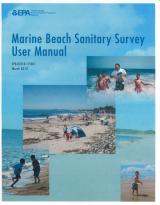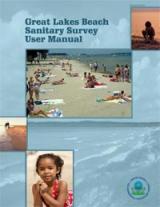Beach Sanitary Surveys
Background
A sanitary survey is a method of investigating the sources of fecal contamination to a water body. Sanitary surveys are typically used for drinking water, shellfish, and watershed protection programs. They can also be used at beaches. Sanitary surveys help state and local beach program managers and public health officials identify sources of beach water pollution, assess the magnitude of pollution, and identify priority locations for water testing.
Beach sanitary surveys involve collecting information at the beach, as well as in the surrounding watershed.
-
number of birds at the beach,
-
slope of the beach,
-
location and condition of bathrooms, and
-
amount of algae on the beach.
-
land use,
-
location of storm water outfalls,
-
surface water quality, and
-
residential septic tank information.
Beach managers can use the sanitary survey results to prioritize state or county resource allocations to help improve bathing beach water quality. In addition, they can use sanitary survey data (e.g., bacteria levels, source flow, turbidity, rainfall) to develop models to predict bathing beach water quality using readily available data.
EPA developed a beach sanitary survey tool, one each for marine and Great Lakes beaches, to help beach managers evaluate all contributing beach and watershed information including water quality data, pollution source data, and land use data. The tool consists of three types of beach sanitary surveys, in paper and electronic form (so that the data can be entered and stored in a database).
Marine Beach Sanitary Survey
EPA updated its beach sanitary survey tool to include survey forms that can be used at marine beaches. As templates, EPA used the survey forms the Agency had developed for the Great Lakes and developed a Routine On-site Sanitary Survey and an Annual Sanitary Survey that are specific to marine beaches. The survey forms include detailed questions on winds, tides, and other characteristics that affect marine beaches and were not included on the surveys for the Great Lakes.
- Fact sheet (April 2013)
- Sanitary Survey User Manual (EPA-820-F-13-001; March 2013)
- Annual Sanitary Survey (EPA 820-F-13-007; March 2013)
- Routine On-Site Sanitary Survey (EPA 820-F-13-008; March 2013)
Marine Beach Sanitary Survey App
The Marine Beach Sanitary Survey App is based on the routine marine beach sanitary survey form. This survey provides managers of marine beaches with a technically sound and consistent approach to identify pollution sources and share information. To use the app to complete the routine marine sanitary survey form, EPA provides two options for viewing the survey with your tablets.
Marine Sanitary Survey Webinar
On March 25, 2014, EPA held a webinar to introduce the Marine Sanitary Survey Tool, summarize key sanitary survey elements, and provide presentations from practitioners with their perspectives on the use and benefits of the sanitary survey tool.
- Agenda
- Presentation 1: EPA Overview of Marine Sanitary Survey Tool
- Presentation 2: Beach Sanitary Surveys - Old Idea, New Application
- Presentation 3: Strategies to Identify Sources of Bacterial Pollution
For questions about the webinar content email rec_criteria@epa.gov.
Great Lakes Beach Sanitary Survey
The Great Lakes Beach Sanitary Survey has been developed and piloted in the Great Lakes, however it can be used in any beach environment (marine water, inland water).
- News Release (May 30, 2008)
- Fact sheet about the Great Lakes Beach Sanitary Survey (May 2008)
- Great Lakes Beach Sanitary Survey User Manual (including forms and appendices) (EPA-823-B-06-001; May 2008)
- Great Lakes Beach Sanitary Survey Forms
- Great Lakes Pilot Project Summary Report | Appendices to the Summary Report
- Map of Great Lakes beaches with a sanitary survey pilot
Great Lakes Regional Collaboration Strategy
A May 2004 Executive Order created the Great Lakes Interagency Task Force and encouraged creation of a Regional Collaboration of National Significance to address environmental problems. In December 2005, the Great Lakes Regional Collaboration (GLRC) published the Great Lakes Regional Collaboration Strategy to protect and restore the Great Lakes.
Of the Strategy's eight priority elements, the Coastal Health Chapter specifically addresses beach water quality. To that end, EPA is working with the states to develop beach sanitary surveys to identify sources of contamination at Great Lakes beaches.
Other Sanitary Survey Information
- Example Beach Sanitary Surveys
- Example TMDL and Shellfish Sanitary Surveys
- A Guide to Conducting Beach Sanitary Surveys
Instructional video produced by University of Wisconsin-Oshkosh, Exit includes instructions on how to complete a routine and annual beach sanitary survey - Great Lakes Restoration Initiative Beach Sanitary Survey Topics


